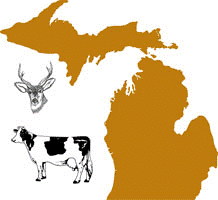Wildlife Disease and Zoonotics
Recommendations for Elimination of Bovine Tuberculosis in Free-Ranging White-Tailed Deer in Michigan
Date of this Version
9-1997
Abstract
A significant infection rate of bovine TB in the deer population of the northeastern lower peninsula poses a potential risk to several important values including public health, United States Department of Agriculture (U.S.D.A.) TB-free accreditation for Michigan cattle, wildlife health, wildlife-related recreation and tourism and economic stability in several sectors. A risk assessment study by the U.S. D.A. Centers for Epidemiology and Animal Health (Fort Collins, CO) predicted that if no changes were made in the management of the affected free-ranging deer population, the TB prevalence (compared to the current prevalence of 2.3%). Although the current annual risk of TB transfer to cattle in the affected area is .I%, the report estimated a 12% cumulative risk that at least one head of cattle would become infected over the next 25 years if no changes are made in deer and/or cattle management.


Comments
Submitted by: State Committee on Bovine TB in Wild Deer - September, 1997.